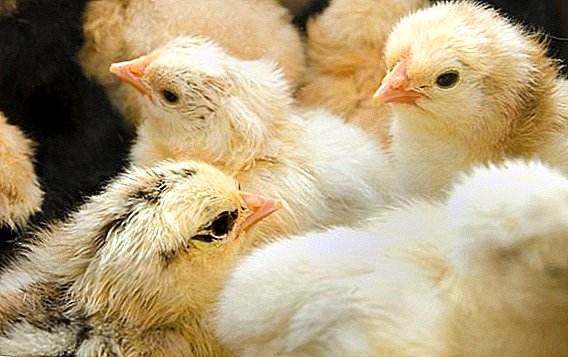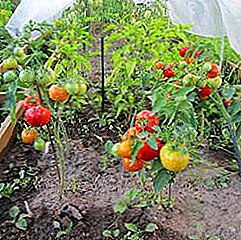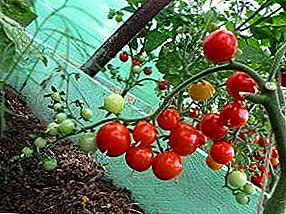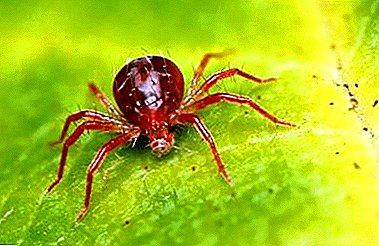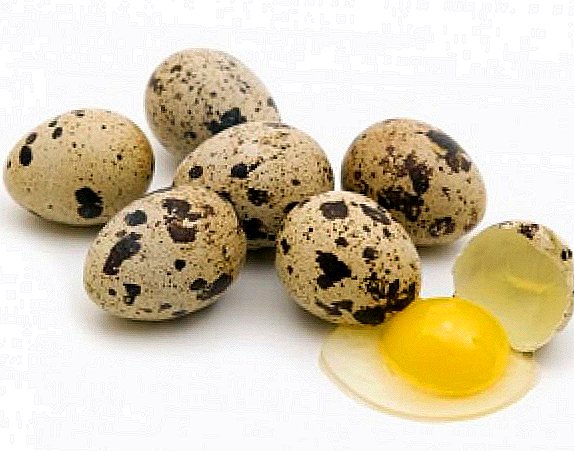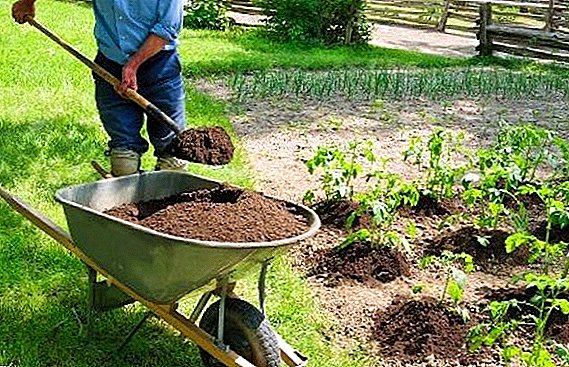 The fresh aroma of lilac under the windows on a warm May night is the best evidence of the victorious spring and the early arrival of summer. Lilac flowers have many shades, aromas and varieties. About what to do to grow the most favorite varieties nearby, we will tell in this article.
The fresh aroma of lilac under the windows on a warm May night is the best evidence of the victorious spring and the early arrival of summer. Lilac flowers have many shades, aromas and varieties. About what to do to grow the most favorite varieties nearby, we will tell in this article.
Cuttings
Like any beauty, lilac is quite capricious, so any method of reproduction requires a lot of effort and has both advantages and disadvantages.
Cutting is the most difficult method of breeding lilac, because you need to adhere to a number of conditions in terms of time, temperature and humidity. However, it is most effective, it is most often used in the mass cultivation of lilacs.
Now, any novice gardener can learn how to propagate lilac cuttings, as there are a lot of teaching materials, including video materials, in free access. 
Learn more about growing Persian and Hungarian lilacs.
Timing
Timely harvesting cuttings, this is one of the main features of this type of breeding. Lilacs are propagated with green cuttings in spring, during flowering or the next week, until the young green branches complete their growth, since the cuttings that have begun to grow are not rooted.
Stocking
It is recommended to harvest cuttings early in the morning. They are taken on young bushes mainly from their middle, choosing growing on the middle part of the shoots. Sprigs need medium thickness, preferably with 2-3 knots and small gaps between them.  Tops and processes on thick branches do not fit, because they do not take root.
Tops and processes on thick branches do not fit, because they do not take root.
At the bottom of the node cut off all the leaves. Then, just below it, make an oblique cut, trying not to injure the plant, for this purpose take a sharp tool, pruner or sharp grafting knife.
If the cut passes through the internode, the stalk will not root. A cutting is cut at the top, right above the top node. The remaining leaves are cut in half.
After such cutting, the cuttings are put in water for 15–18 hours with dissolved growth stimulants, for example, “Epin-extra”, indolyl butyric acid, and an aqueous solution of heteroauxin.
Did you know? Most varieties of lilac bloom in spring, about three weeks, but the variety of Jose or Boomerang, and a number of others, bloom several times during the year.

Rooting
Rooting is best carried out in a greenhouse, it is best to place it in a light shade or to make shelter from the sun.
Preparing the soil, go down by 30 cm, drainage is done by 10 cm, a layer of expanded clay or crushed stone, 15 cm above it is a nutrient layer of peat or humus, all this is filled up by 5 cm of soil or a mixture of sand and peat. This "pie" is carefully tamped and watered.  When watering, you can add antifungal drugs ("Vitaros", "Fundazol"). For covering use a low, up to half a meter frame, which is tightened with a special greenhouse cover, but it can also be covered with two layers of polyethylene with a layer of paper or cloth between them.
When watering, you can add antifungal drugs ("Vitaros", "Fundazol"). For covering use a low, up to half a meter frame, which is tightened with a special greenhouse cover, but it can also be covered with two layers of polyethylene with a layer of paper or cloth between them.
Greenhouse close tightly. The petioles are planted in rows, with a gap of 5-10 cm. Before planting, the cutting butt should preferably be dipped into a root-stimulating powder mixture such as "Kornevin".
The following plants also propagate by cuttings: gooseberry, laurel, campsis, girlish grapes, zamiokulkas, kolery, Chinese juniper, diploadiya, sea buckthorn, blue spruce, blueberry and plum.Cuttings deepened so as to cover the bottom node in the ground. Subsequent watering is done depending on the tightness of the greenhouse from twice a day to once a week, the main thing is to make sure that the soil does not dry out.
To combat mold, cuttings, no more than once a week, are treated with a weak solution of potassium permanganate.
Rooting lasts a long time, from 40 days to a couple of months. Not last weeks, the cuttings need to be aired, and then completely opened. 
Important! Different varieties of lilac rooted in different ways. The rooting of Hope, Buffon and Dream varieties passes without problems, the results of Hortensia, Red Moscow, Jeanne d'Arc varieties are worse, and the varieties of Havermeyr, Ludwig Shpet, Katerina have practically no grafts.
Landing
After rooting the stalk can be transplanted. If it is already autumn, then it is better not to touch them, and transplant them in spring. When rooting happened before the end of summer, then from the beginning of autumn they can be transplanted into the “school” for growing up.
By the completion of root growing, leaflets on the cuttings may darken, this is normal, the main thing is that the buds are alive, then the seedling will take root.  The place for growing is determined by the sun, closed from the wind. Earth is selected light, neutral or slightly acidic. It is fertilized with compost or humus and they dig up shovels on a bayonet.
The place for growing is determined by the sun, closed from the wind. Earth is selected light, neutral or slightly acidic. It is fertilized with compost or humus and they dig up shovels on a bayonet.
The cuttings of fresh roots are very delicate and fragile, so they are transplanted carefully, the soil is not rammed, but only watered, so that the earth is slightly thickened. Seated them in 30 cm from each other.
For the winter, the cuttings are covered with coniferous branches, hay or another dry cover. Lilac grows for about two years, after which it can be planted in a permanent place.
The final landing of lilac is best done at the end of summer - early autumn. When planting the plant should be watered well. The landing site, if you do not take into account the design factor, you need to choose a sunny, warm, with well-drained, neutral fertile soil, preferably even. 
Lilac vaccination
Grafting is the most effective way of breeding varietal lilacs. You can graft not only on the wild, but also on any varietal lilac. A seedling for rootstock can be grown from seed itself, but you will need a couple of years to do this, you can graft it upon reaching a centimeter thickness.
There are many ways of plant grafting, copulation is best for lilacs, ordinary grafting by cutting the bark, splitting, budding with a sleeping kidney (summer) and budding in the butt.
Did you know? Lilac can be planted on young seedlings of ash. Despite their external dissimilarity, these trees belong to the same family. The engraftment is usually successful and as a result we get a very unusual tree.
Timing
If you can cut the lilac only in spring, when flowering occurs, then you can graft most of the season. By the time of vaccination can be divided into spring, before the start of sap flow, and summer, when the tree fully eats juices.
Before sap flow, copulations and grafts are performed. With the onset of sap flow, an ordinary graft is made by cuttings, this usually happens during lilac flowering. The period of budding of a sleeping kidney depends solely on the stage of maturation of the kidneys and begins in the middle or late summer, depending on the region.
Important! Regardless of the period and type of vaccination, it should be done in dry sunny weather.
Procurement of cuttings for a scion is done at the beginning of winter, but it can be done at the end of winter or early spring, before spring grafting.
Scion and stock preparation
If the cuttings were cut at the beginning of winter, they are wounded in sawdust under snow or in a damp cloth, in a package in the refrigerator.
Scion cuttings can be purchased at special farms or from breeders. If cuttings are harvested independently, you need to adhere to a number of conditions.
First, they are taken from well-known, proven bushes in order to know exactly which sort you are planting. The bush should be relatively young, aged from three to ten years.
Well-ripened, annual shoots are cut from the bush, they are cut from the sunny side of the bush, preferably from the south, from the outer part of the crown. It is best to take shoots at the average height of the plant, since the lower ones are usually still small and the upper ones are already too thick to take root.  The best cuttings will be 30-40 cm long and about 7 cm thick, with short internodes and well marked, developed growth buds, they should be from 4 to 5.
The best cuttings will be 30-40 cm long and about 7 cm thick, with short internodes and well marked, developed growth buds, they should be from 4 to 5.
For the stock, you can use bushes of different ages. Only the method of grafting will differ, for example, by copulating into thin shoots, and beyond the bark, the shoots are thicker than one and a half cm. If an adult bush with a thick trunk is grafted, then it is better to vaccinate all skeletal branches.
Did you know? Lilac belongs to the Olive family, and lilac flowers are edible.
Budding process
Budding sleeping kidney - one of the main ways of grafting lilacs. Hold it in July or August. For a stock take two-year-old seedlings or root shoots.
In the run-up to budding, in a couple of weeks, the vegetation is cleared around the rootstock, and at the same time, the lower side shoots and the shoots coming from the roots are cut. Before grafting, the stock rootstock is thoroughly cleaned with a damp cloth.  With a cutting, a sleeping kidney is cut (shield with a peephole). To do this, take the cutting with the lower part in his left hand, place the knife a couple of centimeters above the bud and lightly cut into the tree, hold it a little deeper than the kidney, ending the cut below it.
With a cutting, a sleeping kidney is cut (shield with a peephole). To do this, take the cutting with the lower part in his left hand, place the knife a couple of centimeters above the bud and lightly cut into the tree, hold it a little deeper than the kidney, ending the cut below it.
On the stock rootstock, 3-5 cm from the ground, a T-incision is made on the bark, carefully separating the bark on both sides of the vertical incision. The flap is placed in a T-shaped incision, removing the protruding part with a knife.
Then swabbed the site of vaccination, leaving the kidney with a petiole open. After the accretion of the shield with the barrel, the winding is removed. In early spring, part of the rootstock above the accreted kidney is cut. 
Plant Care
The scion usually takes root in a couple of weeks, but they begin to grow much later, depending on the timing of grafting this or even next summer. Therefore, until the cutting has dried, and the buds are green on it, the graft is considered successful.
The graft garter is removed to prevent it from growing into a tree, and if there is confidence that it will not break off with the wind. To guarantee engraftment, it is necessary to remove the sprouts below the site of inoculation.
Lilacs from root shoots
Probably the easiest way to reproduce lilacs is reproduction of root shoots. This is done by a canopy when the movement of the lilac juice stops and the root system is not so sensitive.
It is advisable to choose a cloudy day. The shrub from which the shoots are taken should be well matured, already flowering. Pre-watering it, separated by a young seedling. Since the young roots are very fragile, this should be done carefully so as not to tear them.
The resulting seedlings, with already formed roots, are transplanted. The only drawback of such breeding is that the new plant will not bloom for about three years. 
Seed propagation
Lilacs are propagated by seeds when they want to grow a stock for the subsequent inculcation of valuable varieties of lilacs or if they want to get a new variety.
The fact is that during flowering, cross-pollination occurs and, as a result, the same lilac does not grow, the flowers will be different.
From the resulting seeds, some plants will be similar to the mother, some will degrade to "dowce" (the flowers will be smaller and less common), they can be used on the stock, and some can grow with flowers superior to those of the mother in splendor, aroma and color. So get new varieties.
Seed harvesting
Seeds are harvested in the fall, they are dried at home for several days until the boxes unfold, the rate of disclosure is due to the lilac variety, if necessary, the seeds are extracted manually.
Seeds are harvested a quarter more than necessary, then to reject substandard seedlings. Harvested seeds are either sown for winter or stratified at home. 
Preparation and seeding
Seeds can be sown before winter right into the ground, make it into an already frozen ground or before the first snow falls. In a clean area, without grass, weeds and other plants, the seeds are dripped a couple of centimeters.
In the spring, after the snow melted, this area is covered with a film, and when the sprouts rise and grow (4-5 leaves appear), they dive and sit more freely.
If the seeds are kept for the winter, they are mixed with wet sand, 3 parts of sand on a part of the seeds, or they are put in wet wipes honey and placed in a refrigerator for several months. In the spring they are sown on a prepared bed under the film, or they are first germinated in containers in the house.
In spring, it is advisable to preliminarily clean the land on beds from thermals from black rot and other fungi.
Seedlings care
During the growing season, the seedlings are fed three or three times per season with organic or potassium-phosphate fertilizers. The timing of seedlings is highly dependent on the variety, but not later than three months.
To protect against soil parasites, the area near the roots is covered with ash. Picks and seating of young stock can be carried out from the end of spring, after the appearance of the second leaf. In this case, sluggish and immature shoots are rejected.  They are transplanted to the main site in the spring of next year. If you do not give them a bush, you can use on the stock. By the spring of the second year the lilac reaches about 80 cm in height, it will bloom for the fifth, sixth season.
They are transplanted to the main site in the spring of next year. If you do not give them a bush, you can use on the stock. By the spring of the second year the lilac reaches about 80 cm in height, it will bloom for the fifth, sixth season.
Growing from cuttings
During reproduction from cuttings, we receive viable seedlings in a year. In an unvaccinated plant, it is important, annual shoots bend down to the ground, fastened in this position and sprinkled with earth. During the season watered.
Grown bushes are separated and planted in the fourth year. With the grafted lilac come in this way, above the site of grafting, the trunk is pulled over with wire, tilted and the plant is covered with earth by two-thirds so that the pulled place is in the ground.
By the end of the season, new roots form above the waist area, after which the layers can be separated and planted.
When you decide how to dissolve the lilac, what method to choose, you need to consider that of its advantages and disadvantages you are critical. Lilac cuttings with green cuttings, although it is difficult and time-consuming, but gives the opportunity to immediately get a lot of seedlings of the required variety.  Grafting provides greater survival of the required varieties of lilac, but requires constant removal of the root shoots. Reproduction by layering is quite laborious, but it allows both to get a large number of cuttings of lilac, and to root an already grafted variety.
Grafting provides greater survival of the required varieties of lilac, but requires constant removal of the root shoots. Reproduction by layering is quite laborious, but it allows both to get a large number of cuttings of lilac, and to root an already grafted variety.
The easiest way to get a seedling from the root of the shoots, but you need to have a mature plant already formed and be careful when planting. Growing seedlings from seed is the most intriguing.
It is quite laborious, flowering in grown plants comes the last, but allows you to get a lot of seedlings, and most importantly, the end result may be unexpected and delightful, lead to the emergence of a new variety of lilacs.


